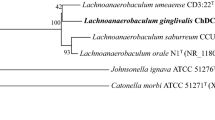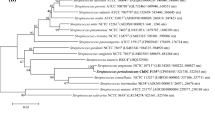Abstract
A novel Gram-stain-negative, motile, and facultative anaerobic coccus, strain ChDC F240T was isolated from human subgingival dental plaque of a gingivitis lesion. The phylogenetic analysis based on the 16S ribosomal RNA gene (16S rDNA) sequence showed that the strain belonged to the genus Lautropia. 16S rDNA of strain ChDC F240T had the highest similarity to that of Lautropia mirabilis ATCC 51599T (98.8%). Major cellular fatty acids of strain ChDC F240T were C16:0 (43.9%) and C16:1ω6C/C16:1ω7C (38.1%). Draft genome of the strain was 3,834,139 bp in length and the G+C content was 65.0 mol%. Average nucleotide identity and genome-to-genome distance values between strain ChDC F240T and L. mirabilis ATCC 51599 T were 81.99% and 28.50% (26.1–30.9%), respectively. These results reveal that strain ChDC F240T is a novel species within the genus Lautropia, for which the name Lautropia dentalis sp. nov. is proposed; type strain is ChDC F240T (= KCOM 2505T = JCM 33297T).

Similar content being viewed by others
References
Bankevich A, Nurk S, Antipov D, Gurevich AA, Dvorkin M, Kulikov AS, Lesin VM, Nikolenko SI, Pham S, Prjibelski AD, Pyshkin AV, Sirotkin AV, Vyahhi N, Tesler G, Alekseyev MA, Pevzner PA (2012) SPAdes: a new genome assembly algorithm and its applications to single-cell sequencing. J Comput Biol 19:455–477. https://doi.org/10.1089/cmb.2012.0021
Ben Dekhil SM, Peel MM, Lennox VA, Stackebrandt E, Sly LI (1997) Isolation of Lautropia mirabilis from sputa of a cystic fibrosis patient. J Clin Microbiol 35(4):1024–1026
Breakwell DP, Moyes RB, Reynolds J (2009) Differential staining of bacteria: flagella stain. Curr Protoc Microbiol Appendix 3:Appendix 3G. https://doi.org/10.1002/9780471729259.mca03gs15
Cho E, Park SN, Lim YK, Shin Y, Paek J, Hwang CH, Chang YH, Kook JK (2015) Fusobacterium hwasookii sp. nov., isolated from a human periodontitis lesion. Curr Microbiol 70:169–175. https://doi.org/10.1007/s00284-014-0692-7
Felsenstein J (1985) Confidence limits on phylogenies: an approach using the bootstrap. Evolution 39:783–791
Gerner-Smidt P, Keiser-Nielsen H, Dorsch M, Stackebrandt E, Ursing J, Blom J, Christensen AC, Christensen JJ, Frederiksen W, Hoffmann S, Holten-Andersen W, Ying UT (1994) Lautropia mirabilis gen. nov., sp. nov., a gram-negative motile coccus with unusual morphology isolated from the human mouth. Microbiology 140(Pt7):1787–1797
Kajitani R, Toshimoto K, Noguchi H, Toyoda A, Ogura Y, Okuno M, Yabana M, Harada M, Nagayasu E, Maruyama H, Kohara Y, Fujiyama A, Hayashi T, Itoh T (2014) Efficient de novo assembly of highly heterozygous genomes from whole-genome shotgun short reads. Genome Res 24:1384–1395. https://doi.org/10.1101/gr.170720.113
Kim HS, Lee DS, Chang YH, Kim MJ, Koh S, Kim J, Seong JH, Song SK, Shin HS, Son JB, Jung MY, Park SN, Yoo SY, Cho KW, Kim DK, Moon S, Kim D, Choi Y, Kim BO, Jang HS, Kim CS, Kim C, Choe SJ, Kook JK (2010) Application of rpoB and zinc protease gene for use in molecular discrimination of Fusobacterium nucleatum subspecies. J Clin Microbiol 48:545–553. https://doi.org/10.1128/JCM.01631-09
Kimura M (1980) A simple method for estimating evolutionary rate of base substitutions through comparative studies of nucleotide sequences. J Mol Evol 16:111–120
Lee I, Kim YO, Park SC, Chun J (2016) OrthoANI: An improved algorithm and software for calculating average nucleotide identity. Int J Syst Evol Microbiol 66:1100–1103. https://doi.org/10.1099/ijsem.0.000760
Luo R, Liu B, Xie Y, Li Z, Huang W, Yuan J, He G, Chen Y, Pan Q, Liu Y, Tang J, Wu G, Zhang H, Shi Y, Liu Y, Yu C, Wang B, Lu Y, Han C, Cheung DW, Yiu SM, Peng S, Xiaoqian Z, Liu G, Liao X, Li Y, Yang H, Wang J, Lam TW, Wang J (2012) SOAPdenovo2: an empirically improved memory-efficient short-read de novo assembler. Gigascience 1:18 (Erratum in: Gigascience (2015) 4:30)
Meier-Kolthoff JP, Auch AF, Klenk HP, Göker M (2013) Genome sequence-based species delimitation with confidence intervals and improved distance functions. BMC Bioinform 14:60. https://doi.org/10.1186/1471-2105-14-60
Rossmann SN, Wilson PH, Hicks J, Carter B, Cron SG, Simon C, Flaitz CM, Demmler GJ, Shearer WT, Kline MW (1998) Isolation of Lautropia mirabilis from oral cavities of human immunodeficiency virus-infected children. J Clin Microbiol 36(6):1756–1760
Saitou N, Nei M (1987) The neighbor-joining method: a new method for reconstructing phylogenetic trees. Mol Biol Evol 4:406–425
Tamura K, Stecher G, Peterson D, Filipski A, Kumar S (2013) MEGA6: molecular evolutionary genetics analysis version 6.0. Mol Biol Evol 30:2725–2729. https://doi.org/10.1093/molbev/mst197
Tatusova T, DiCuccio M, Badretdin A, Chetvernin V, Nawrocki EP, Zaslavsky L, Lomsadze A, Pruitt KD, Borodovsky M, Ostell J (2016) NCBI prokaryotic genome annotation pipeline. Nucleic Acids Res 44:6614–6624. https://doi.org/10.1093/nar/gkw569
Acknowledgements
This research was supported by the Bio & Medical Technology Development Program of the National Research Foundation (NRF) funded by the Ministry of Science and ICT (2017M3A9B8065844), in part by the National Research Foundation of Korea (NRF) grant funded by the Korea government (MSIT) (2018R1A2B5002239), and in part by the KRIBB Research Initiative Program funded by the Ministry of Science, ICT and Future Planning.
Author information
Authors and Affiliations
Corresponding author
Ethics declarations
Conflict of interest
The authors declare that they have no conflicts of interest.
Additional information
Publisher's Note
Springer Nature remains neutral with regard to jurisdictional claims in published maps and institutional affiliations.
DPD number: TA00934. GenBank accession number of 16S rRNA gene for strain ChDC F240T: MK748163. GenBank accession number of genome for strain ChDC F240T: RRUE01000000.
Electronic supplementary material
Below is the link to the electronic supplementary material.
284_2019_1761_MOESM1_ESM.docx
Supplementary material 1 (DOCX 42 kb) Supplementary Fig S1. Maximum likelihood (A) and the minimum evolution (B) phylogenetic trees based on 16S rDNA sequences of strain ChDC F240T and type strains of related species. Stability of phylogenetic trees was assessed by bootstrap analysis of 1,000 replicates with MEGA version 6.06 [15]. Bars indicate 0.01 (A) or 0.01 (B) changes per nucleotide position. GenBank accession numbers of 16S rDNA sequences of strains were given in parenthesis.
284_2019_1761_MOESM2_ESM.pptx
Supplementary material 2 (PPTX 1234 kb) Supplementary Fig S2. Flagella were stained using Leifson stain solution and methylene blue. Light microscope image was taken using a CX43 Biological Microscope. Arrows indicate the flagella. Original magnification: ×1,000. Bar = 30 μm.
Rights and permissions
About this article
Cite this article
Lim, Y.K., Park, SN., Lee, WP. et al. Lautropia dentalis sp. nov., Isolated from Human Dental Plaque of a Gingivitis Lesion. Curr Microbiol 76, 1369–1373 (2019). https://doi.org/10.1007/s00284-019-01761-1
Received:
Revised:
Accepted:
Published:
Issue Date:
DOI: https://doi.org/10.1007/s00284-019-01761-1




